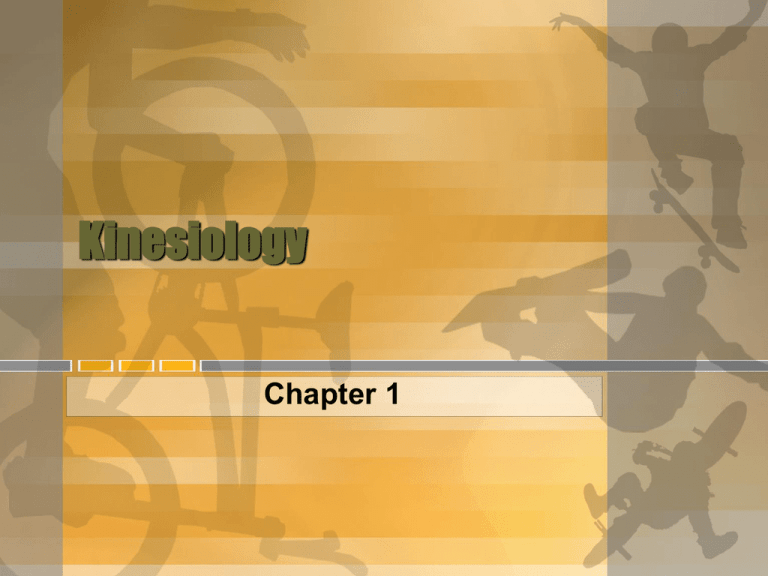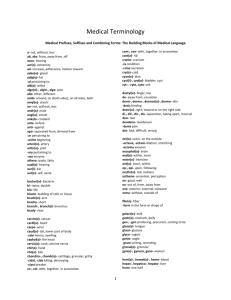Kinesiology
advertisement

Kinesiology Chapter 1 What is kinesiology? • Kines- = ? • -ology = ? • Kinesiology = study of movement 1. Bones of the joints 2. Movements at each joint 3. The muscles that produce those movements Why study kinesiology? • Effective teaching, training, and coaching • Credibility • Knowledge • Thinking skills How to study kinesiology • Daily • Variety – Class – Books – Web sites • Memorization • Logic Anatomical Position General Anatomical Terms – Directional (pages 3-5) • • • • • • • • • • • • Anterior …in front or in the front part Deep …beneath or below the surface Distal …situated away from the center or midline of the body, or away from the point of origin Dorsal …relating to the back, posterior Inferior …below in relation to another structure Lateral …on or to the side; outside General Anatomical Terms – Directional (pages 3-5) • Medial • …relating to the middle or the center; nearer to the medial or midline of the body • Palmar • …relating to the palm aspect of the hand • Posterior • …behind, in back, or in the rear • Proximal • …nearest the trunk of the point of origin • Superficial • …near the surface • Superior • …above in relation to another structure; higher Planes of Motion • Sagittal • Frontal • Transverse (Horizontal) Frontal Plane Sagittal Plane • Anterior and posterior movements. • Passes vertically through the middle of the body, dividing it into left and right halves. – All other sagittal planes run parallel to this median plane, but do not have to pass through the body's midline (parasagittal). – The median plane is merely one example of a sagittal plane. Transverse Plane • Passes horizontally through the body, dividing it into upper and lower halves or (inferior & superior). • Movements through this plane will be horizontally (parallel to the ground); usually rotational Frontal Plane • Passes through the body from side to side, dividing it into anterior and posterior halves. • Movements along this plane will be from side to side or (medial and lateral). Bone Markings (page 10) • Condyle – large round projection • Crest – prominent, narrow, ridgelike projection • Facet – small, flat, or nearly flat surface • Foramen – rounded hole or opening in bone • Fossa – hollow, depression or flattened surface • Head – prominent, rounded projection of the proximal end of a bone Bone Markings (page 10) • Line – ridge of bone less prominent than a crest • Process – any prominent projection • Spine – sharp, slender projection • Trochanter – very large projection • Tubercle – small rounded projection • Tuberosity – large round or roughened projection General Movements (pages 23-27) •Abduction •Adduction •Dorsal flexion •Plantar flexion •Flexion •Extension •Pronation •Supination •External rotation •Internal rotation •Depression •Elevation •Horizontal abduction •Horizontal adduction •Eversion •Inversion Web Sites [pages28-29] • • • • • • • Eaton Hand Web Site Hand Kinesiology University of Washington Orthospine eSkeletons.com Skeletal System PSU Insitefitness



